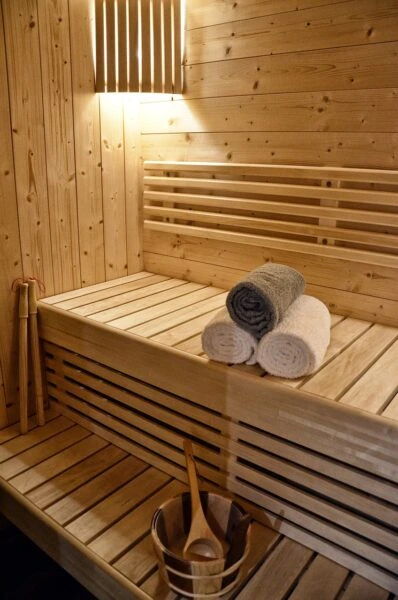Infrared Sauna vs Traditional Sauna: Which One Is Right for You?
So, is an infrared sauna better than a regular sauna? While traditional saunas make use of steam (or hot air) to provide a sauna experience, infrared saunas utilize light to heat your body directly.
Most find that infrared options deliver a more intense, more penetrating heat at much lower temperatures. They usually only get up to 120°F to 150°F, while regular saunas can go up to 195°F. This improves overall comfort with a resulting higher level of comfort with usage for longer periods of time and improved ease of breathing.
Health benefits that both infrared and traditional saunas can deliver include better circulation, detoxification, and relaxation. Knowing these differences allows you to make an informed decision about which type of sauna is best for your personal health and wellness goals.
Here’s what we found. In the next section, we’ll dive into the advantages and disadvantages of both side-by-side.
What Defines Each Sauna Type?
Comparing traditional saunas and infrared saunas is key to knowing which sauna experience is best for you. Both types are designed to promote relaxation, detoxification, and an array of health benefits, but they achieve this in different ways.
Traditional Saunas Explained
Traditional saunas generally rely on high heat and high steam levels to produce a humid environment. They use stoves or heated stones to produce dry heat, with atmospheric temperatures ranging from 150°F to 195°F (65°C to 90°C).
This extreme heat encourages deep sweating that helps cleanse toxins from your body and helps relax both body and mind. Historically, traditional saunas are integral to cultures, especially in Finland, where they serve as social hubs for gathering and bonding.
The vibe is usually very social, enjoyed with family, friends, or new acquaintances, lending to an enjoyable experience.
Infrared Saunas Explained
Infrared saunas tend to use lower temperatures as well, typically between 120°F and 140°F (50°C to 60°C). They still offer an effective heat therapy.
They use infrared heaters or lamps that produce infrared light, which warms the body directly but does not substantially warm the surrounding air. This technique goes deeper into the tissue and offers distinct advantages such as better circulation, pain alleviation, and skin rejuvenation.
Touted as a more pleasant heat, infrared saunas are enticing for longer stays. This energy efficiency means your body absorbs up to 80% of the heat.
This approach to heating the body instead of the room can leave people with considerable savings in short order. The increasing popularity of infrared saunas for at-home use is a testament to their place in today’s wellness practices.
Both sauna types offer unique and worthwhile experiences, appealing to distinct preferences and requirements. Each provides unique benefits that cater to different wellness priorities.
Infrared vs. Regular Saunas: Key Differences
Knowing how infrared and traditional saunas differ is key to choosing the best option for you. This guide will discuss differences in how they heat, temperature differences, energy use, installation and upkeep, and the user experience.
1. Heating Method Comparison
Traditional (or regular) saunas warm the air in a closed space, which then warms your body. Because infrared penetrates the body directly, it has the ability to heat tissues more deeply and help you sweat more at lower temperatures.
Regular saunas, which work by heating the air around you, usually run at 150-190°F. The ambient heat can be enough to make some people uncomfortable and disrupt their experience.
Infrared saunas function at between 120°F and 140°F, which can be more comfortable for individuals who struggle with high heat. They use an estimated 60% less electricity, improving energy efficiency and lowering operating costs.
2. Temperature Variations
The lower average temperatures of infrared saunas promote comfort and relaxation without the extreme heat associated with regular saunas. Saunas at lower temperatures can make the process of detoxification easier and therefore more accessible.
Infrared saunas can provide a more enjoyable sauna experience for heat-sensitive folks, making them steamy and health-promoting all at once.
3. Energy Consumption Differences
Infrared saunas are extremely energy-efficient, using very little electricity compared to traditional models. This efficiency extends to potential long-term cost savings, a factor that drives the decisions of many buyers.
4. Installation and Maintenance
Infrared saunas are typically prefabbed and thus need little installation. Simply plug them in. Traditional saunas require greater space and installation time.
Maintenance varies: infrared models generally require less upkeep, contributing to their appeal.
5. User Experience and Comfort
You might find it hard to breathe in a traditional sauna because of the dry heat. Infrared saunas offer a milder heat that leads to a more pleasant experience.
Comfort is impacted by humidity, as traditional saunas may feel a bit thicker from the moisture. At the end of the day, what type of sauna you enjoy most comes down to personal preference.
Health Benefits: A Detailed Comparison
Here’s a quick overview of their primary health benefits:
- Improved cardiovascular health
- Pain and fatigue relief
- Enhanced mental wellness
- Detoxification support
- Skin health improvements
Cardiovascular Health Impacts
Both types of sauna improve cardiovascular health by raising the heart rate, similar to moderate physical activity. Studies have found that traditional saunas can reduce cardiovascular-related mortality and lower blood pressure levels.
While more emerging studies are needed, early research shows infrared saunas provide similar benefits to traditional saunas. They improve blood circulation and can lower the chances of developing heart disease.
Pain and Fatigue Management
Both traditional and infrared saunas reduce post-exercise muscle soreness and fatigue, with a comparative increase in benefits for traditional saunas. Because infrared heat penetrates deeper, delivering relief at the tissue level, it’s what most users find to be more effective.
Anecdotal evidence points towards individuals with chronic pain conditions benefiting from regular sauna usage of any kind.
Mental Wellness Effects
Not only are sauna sessions relaxing and de-stressing in nature, but there seems to be more at play here. Both infrared and conventional saunas can trigger your body to release endorphins, resulting in a better mood and overall sense of well-being.
On a psychiatric level, regular sauna use can significantly reduce symptoms of depression and psychotic disorders. Research indicates that it can reduce the risk of death from these diseases by 22%.
Detoxification: What Does the Science Say?
Both types of saunas promote detoxification, as sweating is incredibly helpful for detoxing. These are all substantiated by scientific studies, though the latter, toxin-eliminating claims might be slightly more effective through infrared saunas.
Remaining hydrated while using a sauna is key to getting the most out of these benefits.
Skin Health Improvements
Both traditional and infrared saunas enhance skin health by boosting circulation and promoting detoxifying sweat—with infrared specifically targeting acne and dermatitis. For those wondering does sauna increase metabolism, research suggests the heat stress may temporarily elevate calorie burn. Together, these effects contribute to healthier skin and potential metabolic benefits, leaving you with a radiant glow.
A targeted post-sauna skincare routine can amplify these benefits.
Potential Risks and Safety
Educating yourself about the potential risks infrared saunas pose will produce a safe, beneficial experience. It is important to understand a few safety measures to be mindful of.
Dehydration and Overheating
When considering how hot are saunas supposed to be, it’s important to balance benefits with safety. Traditional saunas typically operate at 150-195°F, while infrared saunas use lower 120-150°F temperatures. At these heat levels, dehydration and overheating risks can range from mild dizziness to severe confusion or arrhythmia – making proper hydration and session length crucial.
To offset these impacts, drinking water up to and during your session and afterward is essential. Sipping water or electrolyte-rich drinks will go a long way to keeping fluid levels in check.
To avoid overheating, try starting with a lower temperature and raising it over time as your body adjusts. Understanding your individual heat tolerance has everything to do with paying attention to what your body is telling you.
Cardiovascular Strain Concerns
Overdoing it in the sauna can overtax your cardiovascular system. Those with pre-existing conditions like heart disease should discuss with a healthcare provider before using a sauna.
Sauna sessions can definitely increase heart rate and affect blood pressure. If this is your first time, don’t worry—go at your own pace and get acclimated to the experience!
EMF Exposure in Infrared Saunas
Questions about electromagnetic field (EMF) exposure in IR saunas have been raised. Although infrared saunas do emit EMF, infrared sauna EMF levels are still significantly lower than traditional sauna EMF levels.
Reputable manufacturers take EMF safety seriously and make adjustments to reduce EMF exposure. This way, you can choose sauna types with a proven record for lower EMF exposure.
Contraindications: Who Should Avoid Saunas?
Some health conditions can contraindicate sauna use. This encompasses everything from heart health to maternal health to acute respiratory distress.
Overall, it’s important to evaluate your health condition and seek proper medical guidance before using a sauna.
Safe Usage Guidelines and Precautions
To ensure a safe sauna experience, consider these practices: limit sessions to 15-20 minutes, set temperatures at a comfortable level, and always cool down afterward.
Don’t forget hydration. Drink plenty of water beforehand and when you’re done. Most importantly, always listen to your body. Leave the sauna if you experience any negative symptoms.
Optimizing Your Sauna Experience
To get the most out of your sauna practice, it’s important to set up an experience that invites relaxation and comfort. With just a couple of simple changes, you can enhance your experience and pay huge dividends.
Try adding other ambience creators such as aromatherapy, which will lift your spirits with calming fragrances. Soft music can enhance the ambiance, too, creating a relaxing retreat.
Frequency and Duration Recommendations
Ideally, for the best health benefits, you should be using the sauna 3-4 times a week. If you’re new to using the sauna, make sure to begin with shorter sessions, working your way up as your body acclimates.
15-20 minutes is a reasonable starting goal, but don’t stay in the sauna longer than 30 minutes to reduce overheating risk. Regularity is important because repeated sauna use is associated with greater long-term wellness benefits.
Pre- and Post-Sauna Hydration
Tip #1: Hydrate. Hydration is everything. Here are some tips to ensure you stay hydrated:
- Drink a minimum of 16 ounces of water before sauna use.
- Have a drink of water on hand during your session to take small sips as necessary.
- After a sauna session, drinking plenty of water is essential to rehydrate your body.
Keeping track of your fluid consumption according to the amount of time spent in the sauna will assist in avoiding dehydration.
Monitoring Your Body’s Response
Listening to your body is key when it comes to sauna use. Pay attention to your body. When using the sauna, if you start to feel dizzy or uncomfortable, it’s time to leave.
Modify the session duration and temperature to create a balanced and safe sauna experience that works for you. Tracking your sauna use in a journal or through a sauna app can help you learn what’s most effective for you.
Which Sauna is Right for You?
Selecting which sauna is best for you comes down to a few important characteristics that can sway your choice. Once you have a better understanding of these elements, you’ll be better equipped to select the sauna that best fits your needs.
- Health goals: What are you aiming to achieve?
- Budget: What can you invest upfront and maintain?
- Space: How much room do you have for installation?
- What type of heat and atmosphere do you prefer?
Consider Your Health Goals
Your specific health goals are key in leading you to the right sauna. If you’re looking primarily to lose weight, infrared saunas might be better suited to your needs. They carry heat deeper into the skin than traditional saunas, thus stimulating the body to burn more calories.
If relaxation and stress relief are important to you, both sauna types provide calming experiences. Instead, traditional saunas produce a heat that is humid enough for you to feel it, which most people find soothing. Aligning your sauna use with your overall wellness plan ensures you maximize its benefits.
By taking some time to consider what you hope to accomplish using a sauna, you can tailor your experience to be more rewarding.
Evaluate Your Budget and Space
Money is an important factor to consider when buying and maintaining a sauna. Infrared saunas usually have a lower up-front cost, and installation is less convoluted, making them more attractive for those on a shoestring budget.
Traditional saunas usually need more available space and a larger investment, so consider your current living situation. Factor in long-term expenses, like energy use and maintenance, along with upfront costs to arrive at a decision that works best for you.
Personal Preferences Matter
Your comfort should be your priority when selecting a sauna. Whether you have a low or high heat tolerance, based on experience, the atmosphere makes all the difference in your overall experience.
Experimenting with various sauna types, if possible, will help you gain a better perspective on what feels best for you. Putting your enjoyment first means you will have an enjoyable sauna experience that is as rewarding as it is fun.
Energy Efficiency and Costs
When choosing a sauna, energy efficiency and costs are very important considerations. By understanding infrared vs traditional saunas, you can make an informed decision. The right decision will be the one that best fits your community’s needs and budget.
Initial Investment Comparison
You should be looking to spend $1,000 – $3,000 for infrared saunas. Traditional saunas usually range from $2,000 and up, depending on the size and brand. Here’s a breakdown of what drives the costs.
These factors comprise the materials used, the size of the unit, and even extra features such as built-in lighting or sound systems. When investing in a sauna should consider quality and durability, as a higher price tag often reflects better construction and longevity.
Though the initial costs can be a concern, regular sauna use’s overall health benefits help make it worth the investment.
Long-Term Operational Costs
Ongoing costs for either sauna type can vary significantly. In comparison, infrared saunas tend to be more energy efficient. They’re considerably cheaper for operators, estimated at $0.50 to $1.50 per session, compared with conventional saunas, which typically run between $1 and $3.
Your energy rates and how frequently you plan to use your sauna will have a big impact on your long-term costs. Regardless of the sauna type, regular maintenance is necessary, with repair and maintenance costs contingent on the sauna variety.
Factor these costs into your application. That way, you can easily compare the total cost of ownership over time.
| Feature | Infrared Sauna | Traditional Sauna |
| Initial Cost | $1,000 – $3,000 | $2,000+ |
| Average Session Cost | $0.50 – $1.50 | $1 – $3 |
| Energy Consumption | Lower | Higher |
If you want to own a sauna, considering energy efficiency. So, an infrared sauna is an investment that will save you money in the long term and be a more efficient use of energy.
User Experiences and Preferences
When troubleshooting the differences between infrared vs traditional saunas, user experiences and preferences can be very telling. Thousands of you have submitted your user experiences and preferences, helping demonstrate how well each type meets people’s needs.
Common experiences include:
- Infrared saunas are frequently featured in the media as a more pleasurable experience because they are based on lower ambient temperatures.
- Traditional saunas are favored for the authentic and communal atmosphere.
- Users appreciate the quicker heating time of infrared options.
- Some people report greater relaxation in traditional saunas because of the steam.
Personal experiences and preferences are important in determining just how effective a sauna will be for you. It’s less about what kind of sauna and more about how every individual interacts with their own sauna experience.
Community reviews and testimonials offer a trove of military and spouse insights, allowing great prospective buyers to know what they can expect from you. Personal experiences are always the most powerful, showing in clear ways how various types of saunas have improved the lives of users.
Comfort and Enjoyment Factors
Perhaps the biggest surprise of all was the comfort levels reported by users. Infrared sauna fans usually tout their ability to experience longer sessions without being overheated.
Those who love the classic sauna experience will appreciate the all-around warmth and the calming steam, offering a more enveloping experience. Beyond just temperature control, humidity makes a big impact on user comfort.
Some people will love the deep, penetrating dry heat of an infrared sauna, while others will appreciate the rejuvenating effects of a sauna’s humidified air. After all, when it comes to enjoying the perfect sauna experience, it’s all about what makes YOU comfortable!
Making peace of mind a priority when choosing a sauna will lead to a more rewarding experience.
Perceived Health Outcomes
Users experience health outcomes independently for each sauna type. Relaxation and stress relief remain the top-reported benefits, no matter the sauna type.
The most common themes from testimonials were deeper sleep and recovery from workouts. It is important to note that these health benefits are incredibly subjective, varying from person to person.
Inspire users to advertise their success stories. This step empowers fellow community members with the knowledge they need to make informed decisions based on genuine experiences.
Hybrid Sauna Systems: A Combined Approach
A hybrid sauna system pairs the advantages of both infrared and traditional saunas. This combination makes for a one-of-a-kind experience designed to address numerous wellness concerns. These systems allow patrons to enjoy all the relaxing, restorative benefits of deep-penetrating infrared heat.
Simultaneously, they love the benefits of high humidity and warmth, like in a traditional sauna. The combination works to magnify relaxation and encourage detoxification, because working two approaches simultaneously focuses on numerous health benefits at once. Infrared saunas generally operate at lower temperatures.
The extra moisture in typical, or traditional, saunas is what gives this form of therapy the inviting, day spa vibe. There are incredible and versatile health outcomes that come from using a hybrid sauna. The infrared aspect increases blood flow, relaxes muscles, and helps with weight loss.
At the same time, the steam of a classic sauna supports respiratory health and deeply hydrates the skin. This combined inside-out, outside-in approach provides a truly immersive wellness experience. If you’re a fan of the deeply comforting heat of a traditional sauna, you’ll enjoy a hybrid system.
It pairs that gentle heat with the body-healing benefits of infrared for a perfect healthy escape. This hybrid approach is the dominant practice across the emerging wellness market.
Why a Hybrid Sauna May Be Your Perfect Fit
The good news is that there are plenty of manufacturers now offering models that combine these two technologies.
This allows consumers more flexibility to find the best fit for their lifestyle. Whether you’re a serious athlete or just looking to unwind, hybrid saunas can provide a personalized experience. Most importantly, they’re customizable, meaning they can be tailored to whatever your individual goals are.
Taking a hybrid approach can result in a more effective sauna experience that improves your health and quality of life. As you compare systems, look closely at the areas that matter most to you. A hybrid sauna might just be the ideal product to help fulfill those desires.
Conclusion
The decision between getting an infrared sauna vs a regular sauna comes down to what you need and prefer. The penetrating heat and shorter length of infrared sessions make these saunas well-suited to hectic lifestyles. Traditional saunas offer the classic environment with steam and warmth, creating an exceptional atmosphere for relaxation. Both kinds provide a wealth of health benefits, from relaxing sore muscles to boosting circulation.
Consider what will work best for your lifestyle. Think about the space available, your budget, and what overall health goals you are trying to reach. No matter which route you take, sauna use is a powerful tool to improve your health. Whether that means an infrared sauna or a traditional experience, take the plunge and savor the ride to relaxation and wellness. So what are you waiting for? Begin your sauna journey now!







